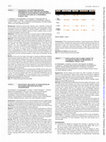Papers by seyed mansoor rayegani

Background Isometric exercises play important role in treatment of Knee OA and are easy to do by ... more Background Isometric exercises play important role in treatment of Knee OA and are easy to do by the growing elderly population. Electromyographic (EMG) biofeedback devices are designed to enhance patient’s participation in these exercises by giving them feedback signals of visual or auditory nature, so that it can affect the subject’s voluntary activity. Objectives The aim of this survey was to study the effect of EMG biofeedback on pain, function, thickness of the vastus medialis oblique muscle and maximal electrical activity of this muscle in isometric contraction, in patients with knee OA. Methods In this single-blinded clinical trial, 46 patients aged between 45 to 70, referring to Shohadaye Tajrish and Shahid Modarres hospitals with diagnosis of knee OA, were recruited. Patients were randomlyassigned to two groups of case (23 patients), with EMG biofeedback associatedexercise, and control (23 patients), with sham biofeedback associatedexercise. The exercise program includes 12 sessions of 15 min isometric quadriceps exercise. Data were gathered via VAS score, the Persian version of WOMAC and Lequesne questionnaires, ultrasonography of VMO muscle and surface electromyography of this muscleat baseline and at the end of 2 months period of this study. Variables compared before and after exercises program in each group and between the two groups. Results At the end of the study, there were no significant differences between the two groups regarding VAS score, VMO muscle electrical activity, maximal VMO muscle thickness, WOMAC and Lequesne questionnaires scores including overall scores and scores in each subcategories. Although all assessed parameters, except for VMO muscle thickness, were found to be improved significantly in each group, the changes were not more significant in case group except for the VAS score. VMO muscle thickness didn’t change significantly after 12 sessions of exercise in either of the groups. Conclusions Isometric exercises accompanied by EMGBF and the same exercises with sham biofeedback for 2 months both lead to significant improvements in pain, and function of patients with knee OA. Real EMG biofeedback was not superior to sham biofeedback. The only parameter found to be improved to a greater extent in the EMGBF group was the subjective measure of VAS score. Disclosure of Interest None declared

Frontiers in Neurology, 2011
Muscle atrophy, spasticity, and deformity are among long term complication of spinal cord injury ... more Muscle atrophy, spasticity, and deformity are among long term complication of spinal cord injury (SCI) veterans. There are numerous studies evaluating effect of functional electrical stimulation on muscle properties of SCI people, but less research has focused on the benefits of passive cycling in the management of spasticity and improving ROM of lower limbs in individuals with SCI. Aims:To evaluate the effect of electrical passive cycling on passive range of movement spasticity and electrodiagnostic parameters in SCI veterans. Methods: Sixty-four SCI veterans referred to two clinical and research center in Tehran were recruited in this prospective clinical trial. The subjects were divided into two groups according to electrical passive cycling usage: (1) patients who did not use pedal exercise (control group), (2) patients used Electrical passive cycling up to optimal level (intervention group). Main outcome measures included hip, knee, and ankle range of motion, spasticity scale, and electrodiagnostic parameters including F-Wave Consistency, F-Wave Amplitude, H/M Ratio, F/M Ratio, H-Reflex Onset Latency, and H-Reflex Amplitude. Data were recorded at the time of receiving and 1 year after pedal exercise usage. Results: Sixtyfour SCI patients including 95.3% male, 4.7% female with mean age 43 years old were included in this study. All patients except one suffered from complete SCI. The involved spinal levels were cervical (17.2%), upper thoracic (34.4%), lower thoracic (45.3%), and lumbar (3.1%). Spasticity scale decreased significantly after passive cycling in group 2. Also hip, knee, and ankle ROM in group 2 were significantly improved after pedal exercise. There was a significant difference in H max/M max (RT<) and F/M ratio after versus before electric passive cycling system in group 2. Conclusion:These findings suggest that passive rhythmic leg exercise can lead to decrease in spasticity, increase in passive ROM of lower limbs and improvement in electrodiagnostic parameters of spasticity in patients with SCI.
Clinical Neurophysiology, Jun 1, 2012
Background Accessory Deep Peroneal Nerve (ADPN) is an anatomic variation that can potentially cau... more Background Accessory Deep Peroneal Nerve (ADPN) is an anatomic variation that can potentially cause disturbance in electrodiagnostic studies. This anomaly could be detected by nerve conduction studies. There are no recent updates about prevalence of this anatomic variation. Electrodiagnostic medicine clinic is the best environment for detecting presence and prevalence of this nerve, so present study enrolled.

IntechOpen eBooks, Aug 2, 2023
Spinal cord injury (SCI) is a debilitating condition that affects millions of people worldwide an... more Spinal cord injury (SCI) is a debilitating condition that affects millions of people worldwide and results in a remarkable health economic burden imposed on patients and the healthcare system annually. The most common causes of SCI are the trauma caused by falls, traffic accidents, or violence. The course of SCI is associated with several complications that severely impair the patient's quality of life, including sensory and motor dysfunction, pain, neurogenic bladder and bowel, autonomic dysreflexia, cardiovascular and pulmonary dysfunction, spasticity, urinary tract infection, and sexual dysfunction. Despite great strides that have been made in the field of regenerative medicine and neural repair, the treatment of SCI still mostly revolves around rehabilitative strategies to improve patients' quality of life and function. Rehabilitation following the SCI is a multidisciplinary process that requires the involvement of multiple disciplines. Moreover, recent advances in the field of neurorehabilitation following SCI, are changing the face of this field. Therefore, we decided to review various aspects of rehabilitation following the SCI, including the goals and different modalities whereby we could achieve them.

BMC Musculoskeletal Disorders
Background Lumbosacral canal stenosis is known as the most common cause of back surgery with seve... more Background Lumbosacral canal stenosis is known as the most common cause of back surgery with several complications. Selecting a minimally invasive treatment with high efficacy in such patients is necessary. This study was designed to evaluate the effectiveness of ozone therapy in combination with caudal epidural steroid in patients with lumbar spinal stenosis. Methods A double-blind randomized clinical trial was conducted on 50 patients with lumbar spinal stenosis allocated into two study groups. Under ultrasound guidance, the first group received 80 mg of triamcinolone hexavalent with 4 mL of Marcaine 0.5% and 6 mL of distilled water to the caudal epidural space. The second group received an injection similar to the first group, combined with 10 mL of ozone (O2-O3) gas at a concentration of 10 µg/cc. The patients were followed at baseline, one, and six months after injection with clinical outcomes measures using Visual Analog Scale (VAS), Walking Distance (WD) and Oswestry Disabili...

CRANIO®
This study was conducted to achieve an understanding of the potential applications of Kinesio Tap... more This study was conducted to achieve an understanding of the potential applications of Kinesio Taping® (KT) in the craniomaxillofacial region. A comprehensive search of pertinent literature was performed through PubMed, Medline, Google Scholar, ProQuest, and ScienceDirect. The focused question that was addressed was, "What are the potential applications of KT in the craniomaxillofacial region?". The preliminary search identified 52 studies. Once duplicates were removed, the remaining 43 titles/abstracts were screened, where 9 studies were excluded and the remaining 34 were assessed. Three additional studies were obtained through reference review of the retrieved articles. KT is being used for the management of various conditions, including temporomandibular joint disorders, side effects associated with maxillofacial surgeries, various neurological conditions, etc. KT has not been proven as a reliable independent treatment option; however, it is considered to be useful as a complementary option to improve treatment outcomes for various conditions.
Medical Journal of The Islamic Republic of Iran, 2022
Previous studies have investigated the advantages and limitations of the guideline adaptation fra... more Previous studies have investigated the advantages and limitations of the guideline adaptation frameworks.

Iranian Journal of Psychiatry, 2021
Objective: The purpose of the present study was to establish the item analysis and internal consi... more Objective: The purpose of the present study was to establish the item analysis and internal consistency of the Persian version of the Child Sensory Profile 2 in 2 groups of typical and atypical children (autism spectrum disorder and learning disabilities) aged 3 to 14 years. Method: The sample of this study included 120 typical and atypical children aged 3 to 14 years who referred to schools and rehabilitation centers in Tehran were selected using multistage sampling method. To collect data, the Child Sensory Profile 2 questionnaire was used, which is a set of questionnaires of the Sensory Profile 2. To analyze the data, the discrimination index was used to determine the discriminant validity of the Child Sensory Profile 2, and the Cronbach's alpha coefficient was used to determine the reliability in terms of internal consistency. Results: Discrimination index was satisfactory for all the items of the Child Sensory Profile 2. The values of Cronbach's alpha ranged from 0.795-...
Interventional Pain Medicine and Neuromodulation, 2021
Larrivee received the Association for Research in Vision and Ophthalmology's first place award fo... more Larrivee received the Association for Research in Vision and Ophthalmology's first place award for studies on photoreceptor degenerative and developmental mechanisms. He is the editor of Brain Computer Interfacing and an editorial board member of the Annals of Neurology and Neurological Sciences (USA) and EC Neurology (UK). He is also the author of more than eight-five papers and book chapters in such varied journals/venues as Neurology and
Annals of Physical and Rehabilitation Medicine, 2018

Journal of Pain Research, 2018
This study aimed to review and pool the current literature on intra-articular ozone injection in ... more This study aimed to review and pool the current literature on intra-articular ozone injection in knee osteoarthritis (OA) patients. Methods: A systematic review of three big databases was performed to identify all Englishlanguage randomized clinical trials (RCTs) that evaluated the efficacy of intra-articular ozone injection vs a control injection for knee OA sufferers, using the following two measuring tools: pain VAS and Western Ontario and McMaster Universities Arthritis Index (WOMAC). Results: A total of 428 patients in five RCTs were included, from which 53% (n=225) were in the ozone group and 47% in the control (hyaluronic acid [HA], dextrose, and air injection) group (n=203). The mean age of the patients in both groups was 64 years. Females were the majority. All studies had at least 2 months of follow-up (F/U). Mean difference (MD) between the groups for VAS in the first month was-0.23 with a P-value of 0.71 (negative value was in favor of ozone), whereas this difference in the third and sixth months reached 1.04 and 1.31, respectively, favoring the control group. These data demonstrated that control injection had a more prolonged pain relief period. A similar trend was seen regarding WOMAC scores; pooled results showed that ozone was slightly better than the control injections during the first month (MD =-7.84 [P=0.15]), but it declined to MD=2.55 and 8.23 at 2-to 3-and 4-to 6-month F/U, respectively, again in favor of control injections. Also, adverse events occurred homogeneously in both ozone (6/150 cases, 4%) and control groups (7/129 cases, 5.4%; P-value=0.31). Conclusion: Based on the current meta-analysis, intra-articular ozone injection efficacy was significantly superior to placebo and slightly lower to other control injections with non-significant difference. Therefore, ozone could be recommended as an efficient non-surgical treatment, durable for at least 3-6 months, in mild or moderate knee OA management.

Osteoarthritis, 2018
Background: Isometric exercises play important role in treatment of Knee OA and are easy to do by... more Background: Isometric exercises play important role in treatment of Knee OA and are easy to do by the growing elderly population. Electromyographic (EMG) biofeedback devices are designed to enhance patient's participation in these exercises by giving them feedback signals of visual or auditory nature, so that it can affect the subject's voluntary activity. Objectives: The aim of this survey was to study the effect of EMG biofeedback on pain, function, thickness of the vastus medialis oblique muscle and maximal electrical activity of this muscle in isometric contraction, in patients with knee OA. Methods: In this single-blinded clinical trial, 46 patients aged between 45 to 70, referring to Shohadaye Tajrish and Shahid Modarres hospitals with diagnosis of knee OA, were recruited. Patients were randomlyassigned to two groups of case (23 patients), with EMG biofeedback associatedexercise, and control (23 patients), with sham biofeedback associatedexercise. The exercise program includes 12 sessions of 15 min isometric quadriceps exercise. Data were gathered via VAS score, the Persian version of WOMAC and Lequesne questionnaires, ultrasonography of VMO muscle and surface electromyography of this muscleat baseline and at the end of 2 months period of this study. Variables compared before and after exercises program in each group and between the two groups. Results: At the end of the study, there were no significant differences between the two groups regarding VAS score, VMO muscle electrical activity, maximal VMO muscle thickness, WOMAC and Lequesne questionnaires scores including overall scores and scores in each subcategories. Although all assessed parameters, except for VMO muscle thickness, were found to be improved significantly in each group, the changes were not more significant in case group except for the VAS score. VMO muscle thickness didn't change significantly after 12 sessions of exercise in either of the groups. Conclusions: Isometric exercises accompanied by EMGBF and the same exercises with sham biofeedback for 2 months both lead to significant improvements in pain, and function of patients with knee OA. Real EMG biofeedback was not superior to sham biofeedback. The only parameter found to be improved to a greater extent in the EMGBF group was the subjective measure of VAS score.
Future Science OA, 2017
Aim: The aim of the study was to carry out a review of published studies on various platelet prod... more Aim: The aim of the study was to carry out a review of published studies on various platelet products in Iranian studies. Materials & methods: Electronic databases were searched for relevant articles. Two review authors independently extracted data via a tested extraction sheet, and disagreements were resolved by a meeting with a third review author. Results: Bone disorders (25%), wound and fistula (16%), dental and gingival disorders (14%) and osteoarthritis (11%) have more relative frequency based on different fields. Conclusion: The necessity of pursuing standard protocols in the preparation of platelet products, stating the precise content of platelets and growth factors, and long-term follow-up of study subjects were the most important points in Iranian studies.

Scripta Scientifica Salutis Publicae, 2017
Introduction: To study the effects of Polarized Polychromatic Noncoherent Light (Bioptron) therap... more Introduction: To study the effects of Polarized Polychromatic Noncoherent Light (Bioptron) therapy on patients with carpal tunnel syndrome (CTS). Methods: This study was designed as a randomized clinical trial. Forty four patients with mild or moderate CTS (confirmed by clinical and electrodiagnostic studies) were assigned randomly into two groups (intervention and control goups). At the beginning of the study, both groups received wrist splinting for 8 weeks. Bioptron light was applied for the intervention group (eight sessions, for 3/weeks). Bioptron was applied perpendicularly to the wrist from a 10 centimeters distance. Pain severity and electrodiagnostic measurements were compared from before to 8 weeks after initiating each treatment. Results: Eight weeks after starting the treatments, the mean of pain severity based on Visual Analogue Scale (VAS) scores decreased significantly in both groups. Median Sensory Nerve Action Potential (SNAP) latency decreased significantly in both groups. However, other electrophysiological findings (median Compound Motor Action Potential (CMAP) latency and amplitude, also SNAP amplitude) did not change after the therapy in both groups. There was no meaningful difference between two groups regarding the changes in the pain severity. Conclusion: Bioptron with the above mentioned parameters led to therapeutic effects equal to splinting alone in patients with carpal tunnel syndrome. However, applying Bioptron with different therapeutic protocols and light parameters other than used in this study, perhaps longer duration of therapy and long term assessment may reveal different results favoring Bioptron therapy.

Clinical Rheumatology, 2016
Shoulder adhesive capsulitis is a condition mainly characterized by a decreased range of motion (... more Shoulder adhesive capsulitis is a condition mainly characterized by a decreased range of motion (ROM), with a lifelong prevalence of 2-5 %. Intra-articular steroid injection is an important treatment in this disease. It has been suggested that ultrasound-guided (US-guided) intra-articular injections are more accurate and effective than blind injections. This randomized clinical trial was designed to compare efficacy and accuracy of US-guided injections versus blind injections of steroid in the glenohumeral joint. Forty-one patients diagnosed with shoulder adhesive capsulitis were included. Patients randomly underwent intra-articular injection either blind or under guidance of ultrasound by a specialist. Immediately after injection, radiograms were obtained to assess the accuracy of injection. Demographic characteristics, their functional status, the severity of pain, and the ROM were gathered and compared between the two groups. Twenty patients in the US-guided group and 21 in the blind group finished the 4-week period of the study. Improvements in pain, ROM, and functional score after 1 and 4 weeks were more prominent in the US-guided group, but the differences were not statistically significant, except for the changes in extension where the improvements were significantly higher in the USguided group (p = 0.01). The accuracy of injections was also higher in the US-guided group (90 % vs. 76.19 %), but the differences were not found to be significant (p = 0.24). USguided injections can be more accurate and yield better improvements in pain, ROM, and function of the patients, but they cost more and are time-consuming.

Topics in stroke rehabilitation
The aim of the present study was to evaluate the effect of applying electroencephalogram (EEG) bi... more The aim of the present study was to evaluate the effect of applying electroencephalogram (EEG) biofeedback (neurobiofeedback) or electromyographic (EMG) biofeedback to conventional occupational therapy (OT) on improving hand function in stroke patients. This study was designed as a preliminary clinical trial. Thirty patients with stroke were entered the study. Hand function was evaluated by Jebsen Hand Function Test pre and post intervention. Patients were allocated to 3 intervention cohorts: (1) OT, (2) OT plus EMG-biofeedback therapy, and (3) OT plus neurofeedback therapy. All patients received 10 sessions of conventional OT. Patients in cohorts 2 and 3 also received EMG-biofeedback and neurofeedback therapy, respectively. EMG-biofeedback therapy was performed to strengthen the abductor pollicis brevis (APB) muscle. Neurofeedback training was aimed at enhancing sensorimotor rhythm after mental motor imagery. Hand function was improved significantly in the 3 groups. The spectral po...
Basic Principles of Peripheral Nerve Disorders, 2012

Neuroscience Letters, 2004
F waves were recorded from abductor hallucis muscle in eight Parkinsonian patients with deep brai... more F waves were recorded from abductor hallucis muscle in eight Parkinsonian patients with deep brain stimulation (DBS) electrodes surgically implanted in their Vim thalamic nucleus in two conditions of DBS ON and OFF. Patients with relatively anteriorly located electrodes exhibited a significant reduction in F wave duration and also in the UPDRS rigidity score of the corresponding foot when the DBS was ON. In contrast, patients with relatively posteriorly located electrodes exhibited no significant difference in F wave duration in the two DBS ON and OFF conditions. The rigidity UPDRS score in the corresponding foot diminished very little in the latter group. Both groups had great improvement in their tremor at rest UPDRS score in that foot when the DBS was ON. Vim surgery is generally accepted to affect tremor mechanisms. However, surgical intervention in anterior parts of Vim has been reported to affect rigidity mechanisms. This correspondence of these two symptoms of rigidity and tremor with the two locations of anterior and relatively posterior Vim may indicate the contribution of mechanisms of rigidity, but not tremor, in enhancement of F wave duration and hyper excitability of spinal motoneuron.

Neurology India, 2012
Objective: To determine the pattern of muscle involvement in patients with ulnar neuropathy at th... more Objective: To determine the pattern of muscle involvement in patients with ulnar neuropathy at the elbow. Materials and Methods: This study evaluated all patients referred for upper limb electrodiagnostic study (EDX) during 2007-2011 and included. patients with clinical signs and symptoms of ulnar neuropathy at the elbow. All patients had nerve conduction studies (NCS) for ulnar neuropathy. Needle electromyography (EMG) of four ulnar innervated muscles, flexor carpi ulnaris (FCU), flexor digitrom profoundus (FDP), first dorsal interosseous (FDI) and abductor digiti minimi (ADM)) was evaluated. Results: During the study period 34 (23 males and 11 females) patients were diagnosed with ulnar neuropathy at the elbow and three of them had bilateral involvement. Muscle involvement by EMG was as follows: FDI: 91.9%, ADM: 91.3%, FCU: 64.9% and FDP: 56.8%. Conclusion: In this study, EMG abnormalities of nerve damage were presented more commonly in the FCU muscle than in the FDP in patients with ulnar nerve lesion at the elbow.











Uploads
Papers by seyed mansoor rayegani